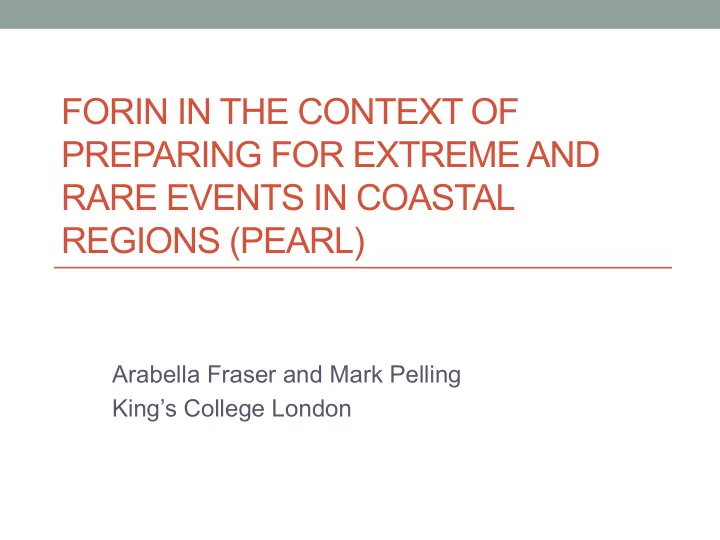

FORIN IN THE CONTEXT OF PREPARING FOR EXTREME AND RARE EVENTS IN COASTAL REGIONS (PEARL) Arabella Fraser and Mark Pelling King’s College London
Presentation structure 1. PEARL 2. Reviewing FORIN in PEARL 3. Developing a Risk and Root Cause Assessment Framework for PEARL 4. Testing the Framework for European flood cases 5. Developing new methods for Root Cause Analysis 6. Reality check: the politics of FORIN research
Preparing for Extreme And Rare events in coastaL regions (PEARL) • 4-year EU funded project (2014-2018) involving 24 partners from 13 countries • Principal aim: to develop adaptive, sociotechnical risk management measures and strategies for coastal communities in Europe against extreme hydro- meteorological events • PEARL Risk and Root Cause Analysis Framework aims to enable systematic assessment of different root causes of risk, risk cascading and propagation of vulnerabilities
Reviewing FORIN in PEARL: Review of Formal FORIN Case Studies Study Strengths of Limits of FORIN Gaps in FORIN FORIN Naruchaikusol, Beckman & Disaster-development Mocjizuki 2013 nexus Integration scenarios Huang ¡et ¡al. ¡2013 ¡ Disaster-development Defining limits Analysing causal nexus relationships Different disaster Holism types Castillo et al. 2013 Holism Climate ‘normals’ Analysing and predicting causal Adaptability Challenges inter- relationships disciplinarity FORIN narrative Characterisation of risk (H=VxE) Transformation Faustino-Eslava et al. 2013 Integration multiple stakeholders Integration scenarios Fujiwara, Sagara & ICHARM Propagation studies of GEJET Infrastructure networks
Reviewing FORIN in PEARL Strengths of FORIN in PEARL: • Broad, adaptable structured framework • Inter-disciplinary, comprehensive and inclusive approach • Link disaster risk and development trajectories • Prioritise governance as driver of risk
Reviewing FORIN in PEARL Developing FORIN in PEARL: 1. A stronger theorisation of, and greater precision of methods for investigating, the governance dimension of disaster causation, 2. A more central focus on the role of the disaster management cycle in perpetuating risk, 3. The connection of a backward-looking, historical perspective on disaster risk causation to a forward-looking, scenarios-based analysis, 4. The development of methods for analysing causal pathways and 5. The development of FORIN indicators for comparative analysis over time and through which to improve the policy update of FORIN.
Reviewing FORIN in PEARL: Setting FORIN alongside the DKKV approach
Reviewing FORIN in PEARL: Setting FORIN alongside the DKKV approach
The PEARL Risk and Root Cause Analysis (RRCA) Framework
Testing the Framework for European flood cases • 16 European coastal flood cases, or sets of cases, where holistic assessments available • Confirmed embeddedness of disaster events in historically configured, inter-related physical, socio- economic, governmental and attitudinal processes • Distinct profile of small-scale events; importance of local government • In every case disaster event reconfigured policies and institutions
Developing methods for Root Cause Analysis • FORIN methods remain appropriate for the RRCA in PEARL • Techniques for linking FORIN work and vulnerability analysis: using qualitative work to inform development of quantitative indicators; setting historical narratives alongside time-series data; weighting of causal factors in stakeholder workshops • Analysis will inform agent-based model
Developing methods for Root Cause Analysis • Additional aim is the development of indicators to track trajectories of root causes • Most indicator sets capture the outcome, but the link to development is missing • Ensuring compatibility with HFA2 and existing UNISDR high-level indicators: more prominent role for sub-national? • UNISDR indicators lack sequence – need for analytic protocol to establish cause and effect
Reality check: the politics of FORIN research • Surprise element in PEARL so far: legal and political blocks to FORIN case study research in Europe
Recommend
More recommend